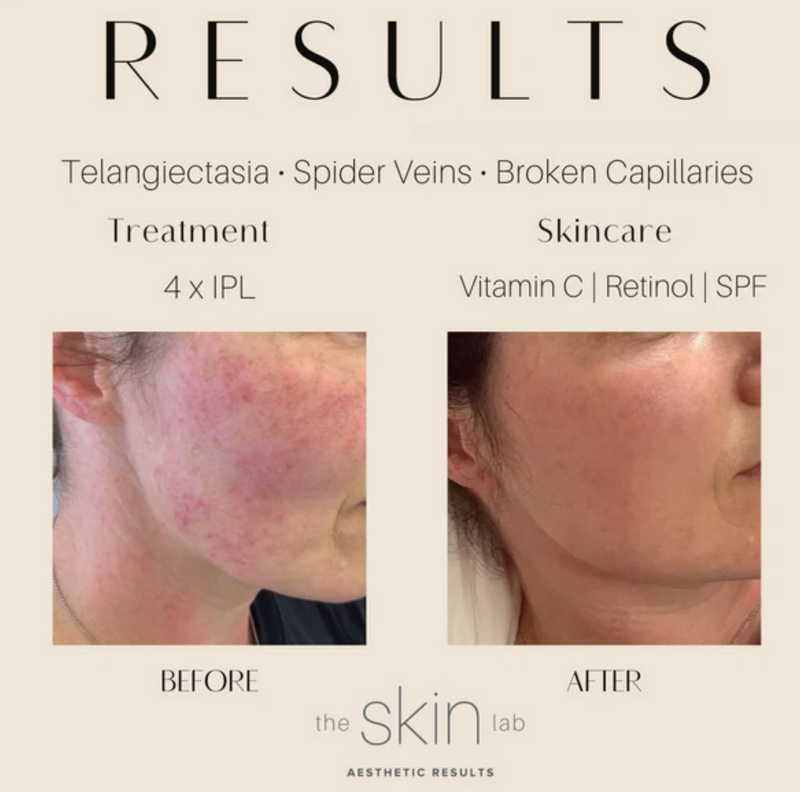Spider Veins & Broken Capillaries

Skin Redness is often associated with vascular skin conditions. Thread veins, spider veins, broken capillaries are medically known as telangiectasias are dilated capillary veins less than 2mm in diameter.
They are often caused by issues with the vascular, or circulatory, system. The skin, also called the dermis, is one of the largest organs in the human body, and it is laced with capillaries that transport nutrients and oxygen in the blood. In some individuals, problems with blood flow or the amount of oxygen in the blood cause certain skin conditions.
Triggers
- SUN EXPOSURE
- HORMONAL CHANGES
- HEREDITY
- ACNE
- AGGRESSIVE SKIN TREATMENTS
- HOT/COLD EXTREMES
The Skin Lab Approach
Each case of vascular skin concern is different and skin responds differently to each treatment. Our focus is on treating the specific skin concern without compromising on overall skin’s health. Our careful selection of treatments and products result in minimum downtime and less stress for your skin.
Recommended Treatments
Depending on the size of the area to be treated, and the depth of the lesion, we recommend
- IPL
- Laser
- Diathermy
CASE STUDY
Skin Concern: Spider veins on both sides of the face causing diffused redness.
Client Profile:Female, 30s, white skin
Our Approach
The first step is a consultation. We gathered as much information as possible about our client’s skincare routine and products, lifestyle, nutrition and medications. This information helped us identify potential triggers that may cause reoccurrence of the veins and redness.
As the veins were very close to the surface of the skin, IPL was chosen as a primary treatment option. IPL. We used ICON MAXG IPL photorejuvenation as it offers superior vessel clearance with minimal downtime. It uses specific wavelengths of light to simultaneously target pigmented and vascular lesions in the skin while stimulating the production of collagen. (Read more about our ICON IPL Rejuvenation)
A total of 4 treatments (4 weeks apart) were performed which resulted in clearance of broken capillaries, reduced redness and improved skin texture.
Skincare products
We recommended using retinol, Vitamin C and SPF to further improve results and minimise the recurrence of the veins. Retinol increases cell turnover and helps reduce the visibility of capillaries because it builds surface collagen in the dermis. Topical Vitamin C (15%) has been shown to be very effective for broken capillaries, veins and diffusde redness in the skin. It strengthens the walls of blood vessels, minimising the appearance of capillaries and evening out overall skin tone (Always use a stable, high concentration formula!
SPF should be the number one skincare product in everyone’s routine. We always say prevention is easier than treatment!
The study by Pennsylvania State University focused on the effects of sunlight, sunscreen and vasodilation (the constriction or dilation of blood vessels). Researchers measured the level of nitric oxide on the skin. Nitric oxide, is an important chemical responsible for vein health. It dilates blood vessels and increases blood circulation. UV exposure reduces levels of nitric oxide thus increasing the risk of vascular conditions. The study showed that an arm treated with SPF was able to maintain higher levels of nitric oxide than one left untreated.
SPF alone won’t prevent spider veins/thread veins/broken capillaries, but it is essential if you want to maintain healthy skin and prevent premature ageing.
